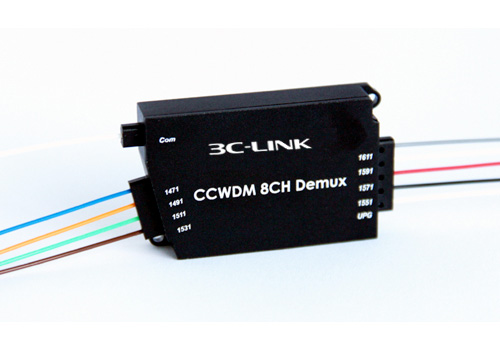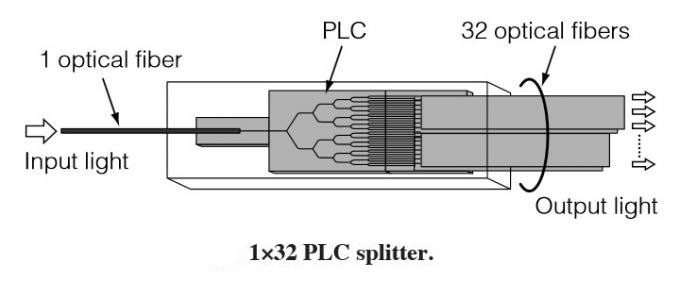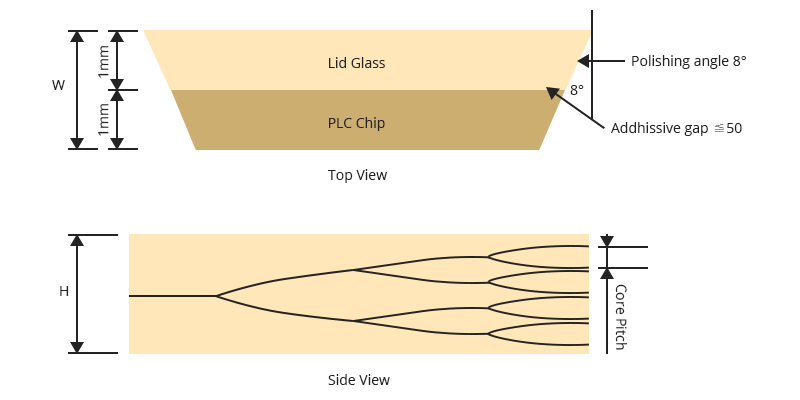
CCWDM Module
PLC splitter known as Planar Lightwave Circuit is used for dividing one or two light beams to multiple light beams uniformly or combining multiple light beams to one or two light beams. It has a passive component with special waveguide made of planar silica, quartz, or other materials. It is mainly applicable to PON (EPON, GPON, BPON, FTTX, etc.) to combine with the MDF (main distribution frame) and the terminal equipment to branch the optical signal.
As a micro-optical device PLC splitter uses optical to split the input signal into various outputs. PLC splitter mainly adopts silica glass as the material of the lightwave circuit and accepts different types of polished finishes. They can be categorized into different types including bare PLC splitters, blockless PLC splitter, ABS PLC splitters, LGX box PLC splitters, mini plug-in type PLC splitters, tray-type PLC splitters, and 1U rackmount PLC splitters. PLC splitters can offer splitting ratio up to 1*64, it is generally higher than the splits of FBT splitter.
PLC splitter is based on Semiconductor technology. As its name shows, PLC splitters are manufactured by planar waveguide circuit technology. PLC splitter design consists of one optical PLC chip and several optical arrays depending on the output ratio. The optical arrays are coupled on both ends of the PLC splitter chip.

Figure 1: PLC Splitter Design
PLC chip is one key component of a fiber PLC splitter. It is available in 1xN (N=2, 4, 8, 16, 32, 64) and 2xN (N=2, 4, 8, 16, 32, 64) splitting ratios. The figure below shows the typical design of a 1x8 PLC splitter chip.

Figure 2: Design of A 1x8 PLC Splitter Chip
PLC Fiber Optic Splitter can be categorized by the PLC splitter chip they use, meaning there are 1xN and 2xN PLC splitters, such as 1x4 splitter, 1x8 splitter, 1x16 splitter, 2x32 splitter, 2x64 PLC splitters, etc. Users can choose different input and output numbers depending on subscriber conditions or cable length. In addition, PLC splitters also can be classified based on different packages to meet clients’ needs in various scenarios, including small size PLC splitter that needs to be used in terminal boxes and big size rack mounted PLC splitter that can be installed in racks. There are five types of PLC splitters in the market: Bare Fiber Optical Splitter, Blockless Fiber Splitter, ABS Splitter, LGX Splitter, and Rack-Mount Splitter.
In Fiber to the Home (FTTH) networks PON (Passive Optical Network) plays an important role. It allows a single PON network interface to be shared among many subscribers. The splitters containing no electronics use no power. These are the network elements that put the passive in Passive Optical Network.
PLC splitter is widely used between PON Optical Line Terminal (OLT) and the Optical Network Terminals/Units (ONTs/ONUs) the OLT services. Networks implementing BPON, GPON, EPON, 10G EPON, and 10G GPON technologies all use simple optical splitters.
The single fiber link coming from the Central Office (CO) OLT is connected with the input of a splitter and is split into a given number of fibers leaving the splitter. The number of outputs in the PLC module determines the number of splits. PLC splitters can be used in centralized PON architecture or categorized architecture. In a centralized PON architecture commonly a 1×32 PLC splitter is used in the Central Office. While in a distributed PON architecture 1×4 PLC splitter is first directly connected to an OLT port in the Central Office and then each of the four fibers is routed to an outside plant terminal box that houses a 1×8/1×4 PLC splitter.

Copyright © 2022 3c-link Corporation Limited.VOKO提供网站技术支持
Privacy Policy